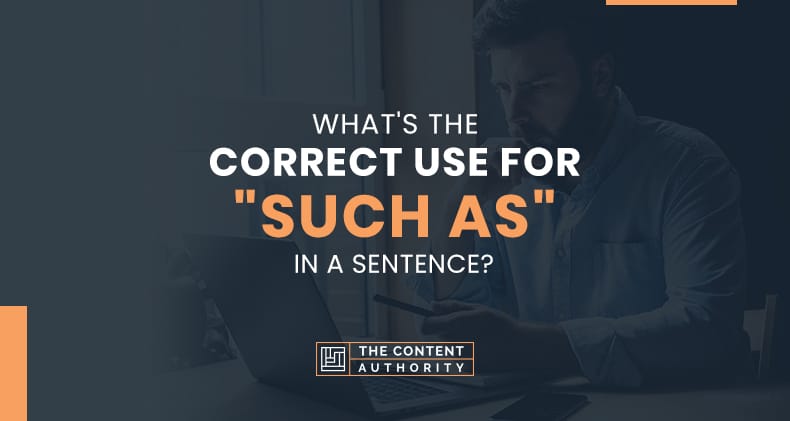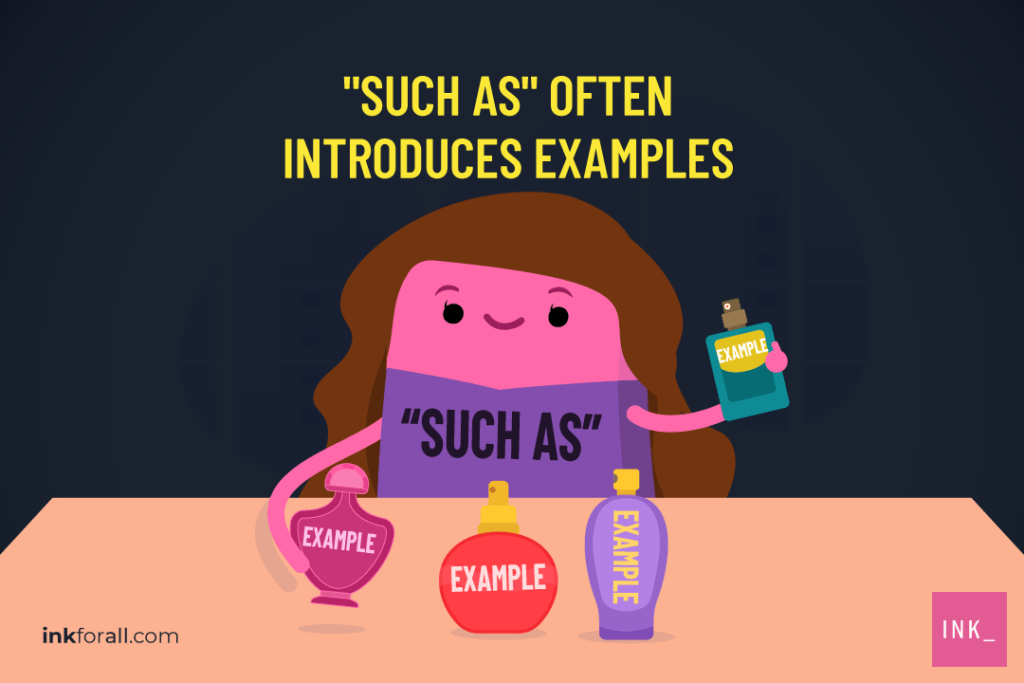How to use such as
How to use such as
What’s The Correct Use For «Such As» In A Sentence?
The phrase «such as» is widely used in the English language, and it is almost impossible to go a day without using or coming across it. But, using a word or a phrase frequently does not mean you know how to use it correctly. There is a lot you need to learn and this article will cover everything.
The phrase «such as» is used as an introduction to an example or series of examples of something mentioned earlier. An example depicting the use of «such as» is: You must have a form of identification, such as a national ID card or driver’s license on you when going out.
You should encounter no problem while learning how to use the phrase correctly. We will make it very simple and easy to understand, so you will not encounter any complexity. Hop in and let’s discover everything about the phrase.
What Does The Phrase «Such As» Mean?
You must not use a word or phrase without having a deep understanding of it and if you have, you should try to find out all you can about the word. You are assured of communicating effectively when you understand a word beyond the surface.
For us to achieve easy and effective communication, we will look at some essential parts of the phrase «such as,» the meaning and the origin. You should be able to use the phrase effortlessly when communicating after reading this article.
The meaning of a word refers to the idea the word conveys when used in a sentence, what the reader infers when they see the word in a sentence. The origin of a word on the other hand refers to where the word was derived from, usually a root word, which is mostly from other languages.
So, What Does The Phrase «Such As» Mean?
The phrase «such as» has a wide range of meanings. Some people refer to it as an idiomatic expression that means something or of a kind mentioned earlier.
It is also used to introduce other examples of the type of thing you just mentioned. An example would be,
There is another meaning to the phrase «such as,» although it is now archaic and outdated, it is good to know it. It means «those who,» an example is,
From the example above explaining the last meaning of the phrase «such as,» a person that is familiar with the modern English language will find it very difficult to comprehend. If you replace the «such as» at the beginning of the sentence with «those who,» the sentence makes a lot of sense.
Next, we will dive into the etymology of the phrase «such as.»
We will look at the separate origins of the words «such» and «as,» this is because «such as» is a phrase, not a word.
The «such» is from the Middle English word «such» (also swich, swulch, swilch, and swuch), this is from an Old English word «swelċ,» gotten from the Proto-Germanic «swalīkaz.»
And the word «as» is from the Middle English word «as» (variations of the word are als(a) and alswa). This is in turn from an Old English «eallswā» a reduced form of «also.»
This is the origin of the root words of the phrase «such as.»
Synonyms and Antonyms of the Phrase «Such As»
Our next focus is on the synonyms and antonyms of the phrase «such as.» First, we will examine some synonyms of the phrase.
To make it more understandable, below are some examples to show how you can use the synonyms of «such as» as an alternative in sentences.
Examples with «Such As»
Examples with the synonyms of «Such As»
On the other hand, the antonyms of the phrase «such as» are,
Examples with the antonyms of «Such As»
These examples should show you how you can use the antonyms of the phrase «such as» in a sentence.
How To Properly Use «Such As» In A Sentence
In this session, we will look at a few tips and additional knowledge that will assist you in using the phrase «such as» in a sentence.
You use the phrase «such as» when you want to provide specific examples of something you are talking about. This means when you are talking or referring to something and you need to provide examples to explain better, you use «such as.»
Another thing you need to know when using the phrase «such as» is the accurate use of punctuation marks before and after the phrase.
You must not use a comma before the phrase «such as» if it is part of a restrictive clause. By restrictive clause, we mean if you take out the phrase the sentence does not make sense. If there is a nonrestrictive phrase, in the sentence, you must use a comma.
An example is you will find a lot of coniferous trees, such as spruce and pine in this forest. The phrase «such as spruce and pine» is nonrestrictive because if you take it out of the sentence, it still makes sense. You will find a lot of coniferous trees in this forest.
You also need to understand that if you are using examples that are not essential in making your sentence accurate and clear, you must add a comma before «such as» and also after the examples, except the example us at the end of the sentence. if the examples make your sentence clear and accurate, you can omit the commas.
We will look at situations you cannot use the phrase «such as.»
You should know that the phrases «such as» and «as such» are very different and cannot be used interchangeably because they do not have any similarity in meaning despite looking very similar. «As such» is used to give a reason for something but «such as» is used when giving examples to make a sentence clearer.
Illustrative Examples on how to use the phrase «Such As»
Here are some examples to simplify the explanations we have provided on how you can use the phrase «such as» correctly in a sentence.
With these examples, you should not find it difficult to use the phrase «such as» in your sentences.
Final Thoughts
You do not have to stress yourself out trying to figure out how to use the phrase «such as» correctly in a sentence.
All you need to do is read up and get the knowledge.
More like this post:
Shawn Manaher is the founder and CEO of The Content Authority. He’s one part content manager, one part writing ninja organizer, and two parts leader of top content creators. You don’t even want to know what he calls pancakes.
2 Simple Tricks for When to use a Comma Before Such As
“Such as” is a common phrase, but how you use it can affect your text’s meaning.
Let’s take a closer look at exactly when to use a comma before such as with some examples along with key dos and don’ts.
Trick #1: When to use a Comma Before Such As
Step 1: Remove the part of the sentence that starts with “such as“.
Step 2: Ask yourself, “Does the meaning of the sentence change?”.
Step 3: If the answer is “no,” then you definitely need to use a comma before “such as“.
This means the phrase is a nonrestrictive clause, or not essential to the sentence.
You need a comma to make this fact clear. The comma is like the glue that holds the two independent parts of the sentence together.
You could remove the nonrestrictive phrase “such as dermatologists,” and the rest of the sentence would still carry the same meaning. “Doctors have to go to medical school for a long time” is true either way.
Including the example of dermatologists adds an explanatory detail.
Always use a comma before “such as” when the latter is a part of a nonrestrictive or nonessential clause.
Trick #2: When NOT to use a Comma Before Such As
Step 1: Remove the part of the sentence that starts with “such as“.
Step 2: Ask yourself, “Does the meaning of the sentence change?”.
Step 3: If the answer is “yes,” then you don’t need to use a comma before “such as”.
This means the phrase you removed is a restrictive clause and is essential to the sentence.
Since the phrase is a necessary part of the sentence, it’s already naturally part of the sentence flow. As a result, you don’t need any comma glue to hold the sentence together.
In this example, removing “such as cows and dogs” would suggest that all animals have four legs.
That would exclude birds, fish, and other animals that have no legs at all and insects such as spiders that have way more appendages.
Main Comma Before Such as Takeaways:
We often use such as when we’re introducing examples. Note that citing examples can help make statements, particularly complex ones, easier to understand.
Examples of Using a Comma Before Such As in a Sentence
As you get the hang of commas and “such as,” we have a tip to help make it easier.
All you have to do is remove the phrase and see whether the rest of the sentence is still true to the original meaning.
If you take out “such as lemon and lime,” the meaning of the sentence changes. You’d suddenly be saying all fruit has a citrus flavor rather than clarifying that fruits like lemon and lime taste like citrus.
In these examples, it could go either way. It’s important to know the intent of the writer.
If the author isn’t good at all sports and soccer and basketball are examples, then a comma is necessary.
However, if the subject is good at some sports but not soccer and basketball, then no comma should be used.
What Does “Such As” Mean?
“Such as” is a more formal synonym for “like”. It frequently introduces an example. There may be one item or several, all elaborating on the idea that came earlier in the sentence.
Thanksgiving, Christmas, and St. Patrick’s Day are all examples of holidays the author loves.
More on Restrictive vs. Nonrestrictive Clauses When Using Such As
Putting a comma in front of “such as” will depend on whether the clause that comes next is restrictive or nonrestrictive. Don’t worry—this might seem like a complicated concept, but you’ll be a pro in no time.
Restrictive clauses starting with “such as” don’t need a comma. Nonrestrictive clauses beginning with “such as” should start with a comma.
Restrictive Clauses: You Don’t Need the Comma
A restrictive clause is also known as an essential clause because it’s a necessary part of the sentence. In other words, if you remove a restrictive clause, the meaning of the sentence would no longer be the same. Restrictive clauses that use “such as” typically do not require a comma first.
If you remove “such as crossword puzzles and Sudoku” from the sentence, the meaning will change. That makes the clause restrictive, and it would not require the use of a comma.
Nonrestrictive Clauses: You Need the Comma
A nonrestrictive clause with “such as” at the end of a sentence must begin with a comma and end with a period.
A nonrestrictive clause isn’t essential to a sentence. It may describe the object of that sentence, but if you omitted the clause, it won’t change the sentence’s overall meaning. We use these clauses to include extra details in your sentence.
It’s common to use commas to help separate a nonrestrictive clause from the rest of the sentence. A nonrestrictive clause beginning with “such as” is in the middle of a sentence, it’s usually offset with commas.
Is it good to remind the audience that they make great wine in Tuscany? Sure, but even if you remove the phrase “where they make incredible wine,” the rest of the sentence carries the same meaning.
“Such as” can be a handy tool when utilized correctly. Use it to expand on an idea, paint a more specific picture, and be sure your audience understands what you’re trying to say. All it takes is a little curly comma, and you’re in business!
guinlist
Advanced Grammar and Vocabulary in Academic & Professional English
53. “As”, “Like” and “Such As”
“Such as” introduces an example, “like” an example or a similarity, and “as” an example, similarity or role
THE CONFUSING NATURE OF “As”, “Like” AND “Such As”
Some uses of as, like and such as are very similar. In some languages, indeed, all three are sometimes translated by the same word. Explanations of the difference between as and like are easily found in mainstream grammar books, but mentions at the same time of such as are rare. My hope here is to offer a clear explanation of the more confusing aspects of the overlapping uses of these three expressions.
Part of the problem with investigating how the three expressions differ is that grammar is involved as much as meaning. There are both preposition uses to consider and conjunction ones.
PREPOSITION USES 1 (Adjectival)
Prepositions need a partner noun, often called their “object”, which usually goes just after them (see 84. Seven Things to Know about Prepositions). The two together – known commonly as a preposition phrase – act sometimes like an adjective and sometimes like an adverb. In the first case they say something about a noun placed either just in front of them or earlier and separated by a link verb like BE; in the second case they say something about a verb or the sentence as a whole. Many preposition phrases have both uses, but some have only one (see 164. Fixed Preposition Phrases).
Preposition phrases starting with as, such as or like can easily act like adjectives, but they normally need to come immediately after the noun they describe. In the following examples, this noun is prisons.
(a) Prisons as rehabilitation centres are a failure.
(b) Prisons, such as/like Alcatraz , instil fear in most people.
(c) Prisons such as/like Alcatraz instil fear in most people.
(e) Prisons like hospitals instil fear in most people.
The meanings of as, such as and like used like this are as follows:
As means “in the role of” or “in the form of” or even “with the purpose of”. It suggests that the noun after it is naming a special use of the noun before.
Such as introduces one or more examples, like for example (see 1. Simple Example-Giving and 54. Sentence Lists 1: Incidental). It normally indicates that the idea mentioned after it – Alcatraz above – is part of a larger group shown by the noun before – prisons above (though see 228. Exotic Grammar Structures 5, #1 for an exception). As a result, the noun before must normally be either plural or a generalizing singular, e.g. a prison.
Such as phrases may go inside two commas, as in (b), or not, as in (c). The difference is similar to that made by using or not using commas with who or which or that (see 34. Relative Pronouns and Commas and 77. Apposition). In other words, sentence (b) is about all prisons, while (c) narrows the meaning of prisons, making it refer to only some (the Alcatraz kind).
Like can be used in much the same way as such as to introduce an example. However, it is probably more used like this in spoken than written English.
Like can also be used both with and without commas to show a similarity, as in (d) and (e). The use with commas actually creates adverbial phrases, I think, rather than adjectival ones, because they do not have to follow a noun – they can be right at the start of the sentence with a comma after them. For more about this use, see 56. Comparing with “Like” and Unlike” and 149. Saying How Things are Similar. On the other hand, like phrases without commas, as in (e), are adjectival. They narrow the meaning of the general noun before them, just as in the exemplifying use. Note that similarity-showing like cannot be used after the same (see 87. “Same As” versus “Same That”).
You can tell whether a like phrase is giving an example or a similarity by comparing the noun after it with the noun before. If the noun after like means something that is part of what the noun before it means (in the way that Alcatraz means part of the idea of prisons), then an example is being given; whereas if the noun after like does not mean part of what the preceding noun means (in the way that hospitals is not part of what prisons means), then a comparison is being made.
A further indication that like is making a comparison is its ability to follow one of a select group of “degree” adverbs: a little, exactly, just, mostly, much, quite, rather, roughly, slightly or very (see 262. Adverbs that Link with a Preposition).
Note that a noun before the comparing use of like does not have to have plural or general meaning. Here is a non-general one:
(f) The new virus produced an illness like influenza.
PREPOSITION USES 2 (Adverbial)
In the examples above, the prepositional as, such as and like all have a noun immediately before them which they and their own noun describe in an adjective-like manner. The other use of preposition phrases – not describing a preceding noun, and hence adverb-like rather than adjective-like – is also possible with as and like, but not with such as. Consider these:
Here the word before each preposition (perform) is a verb. The prepositions and their partner nouns are acting like adverbs because they are saying how the action of this verb happens. However, their meanings are still more or less unchanged: as means “in the role of” while like means “similarly to”. Thus as says the recruits were clowns, while like says they were not, but just resembled them (see 149. Saying How Things are Similar). The resemblance is probably not strong: a stronger one could be expressed with …as if they were clowns (see 191. Exotic Grammar Structures 3, #3).
This adverb-like use of prepositional as phrases is easily confused with the complement use in sentences such as the following:
In both cases, the noun after as stands for the same person or idea as the sentence subject − clowns = recruits in (g); a challenge = grammar in (i). The difference is perhaps that in the complement use as does not mean “in the role of” or “in the form of” (see 220. Features of Complements, #4).
CONJUNCTION USES
1. Comparison
As and like (but not such as) can also be conjunctions, in other words used with a verb in addition to a noun after them (see 174. Eight Things to Know about Conjunctions, #1). In this role, they can both introduce a comparison like this:
Like here is rather informal but not very different in meaning from the preposition uses above. As, however, is not the same as above, since it now means the same as like, and hence indicates that the nouns before and after refer to two similar things, not one thing with two names.
The verb after as/like in (j) is can, a stand-alone auxiliary understood as an abbreviated repetition of the main verb can follow (see 36. Words Left Out to Avoid Repetition). Such auxiliaries are the normal requirement after this use of as/like. The as/like part as a whole in (j) says how the action of the main verb is carried out. The sentence means, as a result, that the way adjectives can follow BE is the same as the way nouns can.
It is also possible to write (j) with a comma before as/like. That would link the words after it with all of the words before rather than just the verb. The sentence would then not be saying anything about the way adjectives can follow BE, but would simply be asserting their ability to do so and their similarity to nouns in this respect. Another possibility after a comma is to reverse the order of the noun and verb following as (…as can nouns). For more about this, see 159. Exotic Grammar Structures 2, #1.
The fact that the conjunction as can mean practically the same thing as the preposition like allows us to paraphrase one as the other. Sentence (h) above, for example, can be paraphrased with as like this:
This compares new recruits with clowns, just as (h) does. The important thing to remember here is that without the do there is no comparison, only the meaning of “in the role of”.
2. A Special Exemplifying Use Of “As”
Having indicated that as cannot generally be used for giving an example, I have to mention one important exception. This is in sentences like (l):
(l) The letter “u” is sometimes pronounced like “e”, as in “bury”
Such as or such. as
What’s the difference between these two constructions?
The writing class developed skills such as critical thinking, brainstorming strategies, and ways to overcome writer’s block.
The writing class developed such skills as critical thinking, brainstorming strategies, and ways to overcome writer’s block.
2 Answers 2
In this particular context there is no significant difference, but in other contexts there may be.
X such as A,B,C. has two significantly different uses. The list A, B, C may be either
I prefer playwrights such as Ibsen, Shaw and Brecht to playwrights such as Wilde and Maetrlinck.
non-restrictive: an incidental illustration of X, as if to say for example A,B,C. When this use is intended, such as A, B, C is set off with commas or parentheses.
I prefer politically conscious playwrights ,such as Ibsen, Shaw and Brecht ,to mere
aesthetes ,such as Wilde and Maeterlinck.Such X as A, B, C. , however «embraces» the X modified within the construction, and thus cannot be used non-restrictively.
OK I prefer such playwrights as Ibsen, Shaw and Brecht to such playwrights as Wilde and Maetrlinck.
BUT NOT
✲ I prefer such politically conscious playwrights ,as Ibsen, Shaw and Brecht ,to such mere
aesthetes ,as Wilde and Maeterlinck.Note that such can act as a pronoun, so you may if you like drop the second instance of X:
OK I prefer such playwrights as Ibsen, Shaw and Brecht to such Ø as Wilde and Maetrlinck.
In my own writing I mark the restrictive/non-restrictive distinction a little more systematically by using X such as A, B, C. only non-restrictively; but I doubt anybody notices, and you are by no means bound to follow my example.
✲ marks an utterance as unacceptable
Ø marks the point at which a term has been deletedGiving examples in English with “SUCH AS”
27th January 2018 by Andrew 1 Comment
We use “ such as ” to give a list of examples of something we say.
Example:
Mark: What kind of music do you like?
Andrew: I like groups such as Radiohead, New order, Placebo and REM.The words after “ such as ” are the examples of groups that I like. If there are several examples, we separate them with commas. We separate the last example with “and”.
More examples:
The shop sells computer parts such as keyboards, screens and disk drives.
Actors such as Brad Pitt and Tom Cruise have made lots of films.
Websites such as facebook and twitter are very popular.
In big cities such as London and Tokyo, accommodation is very expensive.
“such as?” – Short questions
Examples:
Image by photostock | FreeDigitalPhotos.net
Other English lessons and tutorials
Video lesson about “such as”













 Image by photostock | FreeDigitalPhotos.net
Image by photostock | FreeDigitalPhotos.net